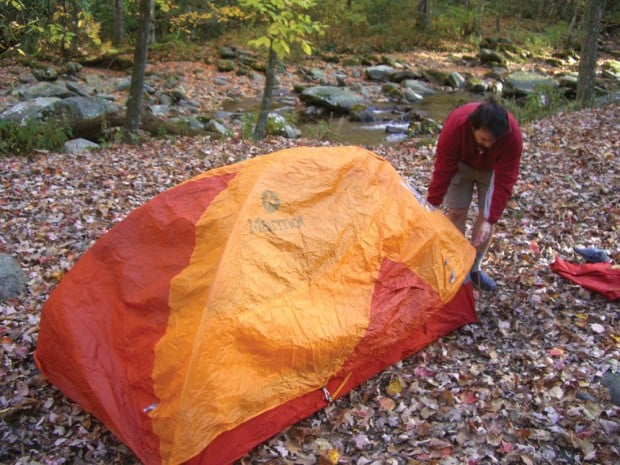I’m preparing for my first weekend backpacking trip. Do I need to buy hiking boots, or will my trail runners do the job?
A good pair of backpacking boots will provide the ankle support you’ll need when hiking on a technical trail with a load on your back. If you’re a beginner backpacker, you’re not used to carrying a full pack, so the risk of twisting an ankle is even greater. But if this is your first trip, don’t buy boots right away. If you keep the mileage low, the terrain easy, and your pack weight minimal, you should be able to get by with your trail runners.
—Erik Plakanis, backpacking guide service owner
How to store your tent and sleeping bag.
On the Trail
Tents: Some people stuff, some roll, some fold. I’m a stuffer. If you fold, try not to fold the tent in the same places each morning, because creases will develop that will eventually compromise the strength of the fabric.
Sleeping Bags: Stuffing is really your only option with a bag. Creases and folds will ruin the shell and down.
At Home
Tents: Air out your tent so mildew and funk don’t fester. Set it up outside and let the sun and wind dry the tent completely. Once it’s completely dry and clean, stuff it back into its sack and store it in a dry place.
Sleeping Bags: Hang your bag out of its compression sack in order to extend the life of the down. If you store your bag inside its sack, you’re compressing the loft and decreasing the amount of warmth the bag will provide in the future.
—Minya James, A.T. thru-hiker and instructor of backpacking workshops
Shelter Etiquette
The system of shelters interspersed along the Appalachian Trail can simplify your backpacking trip immensely. But there are some unwritten rules that govern these backcountry hotspots. David “AWOL” Miller, thru-hiker and author of The A.T. Guide, offered his top five tips for peaceful communal living.
1. First come, first serve. Shelter spaces cannot be reserved for your friends who have yet to arrive. Generally, you should use little more space than the width of your sleeping bag.
2. Turn off alarms and phone ringers. And don’t talk on a cell phone within earshot of the shelter.
3. Do your dishwashing, tooth brushing, and urinating well away from the shelter.
4. Pack it in, pack it out. Don’t leave anything in the shelter, even if you think it may be of use to other hikers. And do not attempt to burn waste.
5. If you know that you have a powerful snore, consider tenting.
5 Ways to Shed Pounds
Pro hiker Andrew Skurka completed a recent 4,700-mile expedition in Alaska with a pack weight under ten pounds. Here’s his advice:
Take less. After every trip, lay out everything and divide into two piles: things you needed, and things you didn’t.
Take lighter gear. Focus on replacing outdated gear, especially your heaviest items: sleeping bag, shelter, stove, and clothing.
Use versatile, multiple-use items. Pitch your shelter with your trekking poles rather than dedicated tent poles. Wear your clothing at night so you can carry a lighter sleeping bag. Use your pack or collapsible water bottle as pillows.
Take calorically dense foods. Fat has twice as many calories as carbs or protein. An average backpacker needs about 3,000 calories per day, or just 12.5 ounces of fat versus 30 ounces of protein and carbs.
Optimize your hydration. A quart of water weighs two pounds. Know where the water sources are, and determine how much water you need between those sources to stay properly hydrated.








